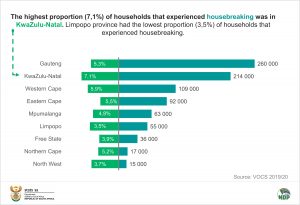Housebreaking still number one crime in SA
Housebreaking or burglary has consistently been the most common crime experienced by households in South Africa. The number of households that experienced this crime in the five years preceding the survey has increased from 2,1 million in 2015/16 to 2,3 million in 2019/20.
This is according to the Governance, Public Safety, and Justice Survey (GPSJS) 2019/20 report released by Statistics South Africa (Stats SA). With an estimated 1,2 million incidences of housebreaking in 2019/20, and affecting 891 000 households in South Africa, this represented 5,3% of all households in the country. While incidents of housebreaking peaked in June and December during the 2018/19 period, housebreaking peaked in June, September, and December in 2019/20.
Home robbery
“Home robbery” is regarded as a violent crime because people are at home when it takes place as compared to “housebreaking” (burglary), which occurs when the family is away from home. An estimated 169 000 incidences of home robberies occurred, affecting 139 000 households in 2019/20. The number of affected households represents 0,8% of all households in the country. About 55% of households that experienced home robbery reported it to the police. However, home robbery has constantly declined between 2015/16 (506 000) and 2019/20 (415 000).
The latest report on crime issued by Stats SA covers a range of crimes experienced by South African citizens. Let us look at some of the key findings of this report.
Theft of a motor vehicle
There were an estimated 88 000 incidences of theft of motor vehicles in 2019/20, affecting 0,5% of South African households. About 79% of households that experienced theft of motor vehicles reported the crime to the police, which is a 7,6% decrease compared to the previous year. Incidences peaked in January, April, September, and November. In terms of provinces, Gauteng (45 000) recorded the highest number of households that experienced car theft, followed by Western Cape (11 000) and Eastern Cape (8 000). Limpopo and Northern Cape (both at 1 000) had the least number of households that experienced car theft.
Murder
The number of incidences of murder increased from 12 000 in 2018/19 to 16 000 in 2019/20. The number of households that experienced murder rose from 12 000 in 2018/19 to 15 000 in 2019/20. All incidences were reported to the police in both periods. Although there was a decline in the number of murders between 2015/16 and 2017/18, and an increase between 2017/18 and 2018/19, data shows stability in the number of murders between 2018/19 and 2019/20.
Theft of personal property
Theft of personal property has consistently been the most common crime experienced by individuals in South Africa. An estimated 1,1 million incidences of theft of personal property occurred in 2019/20, affecting 902 000 individuals aged 16 years and older. The number of affected individuals represents 2,2% of the population. About 38% of individuals who experienced theft of personal property reported it to the police, which is a 6,2% increase compared to the previous year. In general, there has been a significant increase in the theft of personal property between the years 2015/16 and 2019/2020.
Street robbery
The second most common crime experienced by individuals during the five-year period is street robbery. Street robbery increased over the years from 697 000 in 2015/16 to 1,1 million in 2019/20. Males and persons living in the metropolitan areas were more likely to be victims of street robbery. Knives were the weapon of choice used in 47,9% of the street robberies while 34,7% used guns.
Assault
The number of incidences of assault decreased from 497 000 in 2018/19 to 294 000 in 2019/20, experienced by 225 000 individuals (0,6% of persons aged 16 years and older). Knives were the most common weapons of assault and were used in 50,1% of the assault incidences. Males were more likely to be the victims of assault than females. In terms of settlement type, metro areas had more victims of assault compared to non-metro areas. Similarly, urban areas recorded a higher number of victims of assault compared to rural areas. The percentage of individuals that reported the incidences to the police, however, decreased from 50,0% in 2018/19 to 41,4% in 2019/20.
Consumer fraud
A total of 384 000 (1,0% of adults aged 16 and older) individuals experienced customer fraud in a total of 1,4 million incidences. A larger number of these incidences is attributed to advance-fee fraud (e.g. the R99 credit/debit card scam, 419 scams). The percentage of individuals that reported the incidences to the police decreased from 47,0% in 2018/19 to 26,0% in 2019/20.
Hijacking of motor vehicles
An estimated 99 000 hijackings occurred in 2019/20, affecting 85 000 (or 0,2%) persons aged 16 years and older. A total of 78% of the victims reported the crime to the police, which is a 7% decrease compared to the previous year.
Feelings of safety
About 87% of adults aged 16 and older felt safe walking alone in their neighbourhood during the day while 41,8% felt safe walking alone in their neighbourhood during the night. Both figures increased from 2018/19. A larger proportion of females felt unsafe walking alone at night in their neighbourhoods compared to males, while rural residents had a greater feeling of safety walking alone in their areas when it is dark than residents in urban areas.
For more information, download the full report here.


